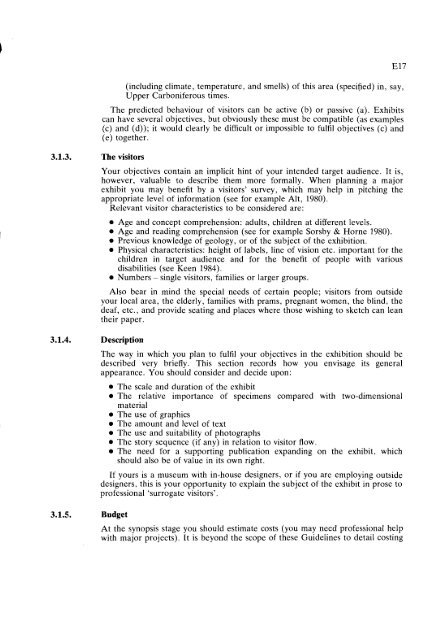GUIDELINES FOR THE CURATION OF GEOLOGICAL MATERIALS
GUIDELINES FOR THE CURATION OF GEOLOGICAL MATERIALS
GUIDELINES FOR THE CURATION OF GEOLOGICAL MATERIALS
You also want an ePaper? Increase the reach of your titles
YUMPU automatically turns print PDFs into web optimized ePapers that Google loves.
3.1.3. The visitors<br />
3.1.4. Description<br />
3.1.5. Budget<br />
(including climate, temperature, and smells) of this area (specified) in, say,<br />
Upper Carboniferous times.<br />
The predicted behaviour of visitors can be active (b) or passive (a). Exhibits<br />
can have several objectives, but obviously these must be compatible (as examples<br />
(c) and (d)); it would clearly be difficult or impossible to fulfil objectives (c) and<br />
(e) together.<br />
Your objectives contain an implicit hint of your intended target audience. It is,<br />
however, valuable to describe them more formally. When planning a major<br />
exhibit you may benefit by a visitors' survey, which may help in pitching the<br />
appropriate level of information (see for example Alt, 1980).<br />
Relevant visitor characteristics to be considered are:<br />
Age and concept comprehension: adults, children at different levels.<br />
Age and reading comprehension (see for example Sorsby & Horne 1980).<br />
Previous knowledge of geology, or of the subject of the exhibition.<br />
Physical characteristics: height of labels, line of vision etc. important for the<br />
children in target audience and for the benefit of people with various<br />
disabilities (see Keen 1984).<br />
Numbers - single visitors, families or larger groups.<br />
Also bear in mind the special needs of certain people; visitors from outside<br />
your local area, the elderly, families with prams, pregnant women, the blind, the<br />
deaf, etc., and provide seating and places where those wishing to sketch can lean<br />
their paper.<br />
The way in which you plan to fulfil your objectives in the exhibition should be<br />
described very briefly. This section records how you envisage its general<br />
appearance. You should consider and decide upon:<br />
The scale and duration of the exhibit<br />
The relative importance of specimens compared with two-dimensional<br />
material<br />
The use of graphics<br />
The amount and level of text<br />
The use and suitability of photographs<br />
The story sequence (if any) in relation to visitor flow.<br />
The need for a supporting publication expanding on the exhibit, which<br />
should also be of value in its own right.<br />
If yours is a museum with in-house designers, or if you are employing outside<br />
designers, this is your opportunity to explain the subject of the exhibit in prose to<br />
professional 'surrogate visitors'.<br />
At the synopsis stage you should estimate costs (you may need professional help<br />
with major projects). It is beyond the scope of these Guidelines to detail costing

















